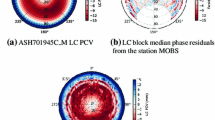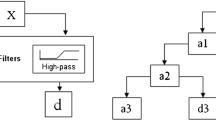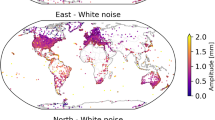Abstract
Proper modeling of seasonal signals and their quantitative analysis are of interest in geoscience applications, which are based on position time series of permanent GPS stations. Seasonal signals in GPS short-baseline (< 2 km) time series, if they exist, are mainly related to site-specific effects, such as thermal expansion of the monument (TEM). However, only part of the seasonal signal can be explained by known factors due to the limited data span, the GPS processing strategy and/or the adoption of an imperfect TEM model. In this paper, to better understand the seasonal signal in GPS short-baseline time series, we adopted and processed six different short-baselines with data span that varies from 2 to 14 years and baseline length that varies from 6 to 1100 m. To avoid seasonal signals that are overwhelmed by noise, each of the station pairs is chosen with significant differences in their height (> 5 m) or type of the monument. For comparison, we also processed an approximately zero baseline with a distance of < 1 m and identical monuments. The daily solutions show that there are apparent annual signals with annual amplitude of ~ 1 mm (maximum amplitude of 1.86 ± 0.17 mm) on almost all of the components, which are consistent with the results from previous studies. Semi-annual signal with a maximum amplitude of 0.97 ± 0.25 mm is also present. The analysis of time-correlated noise indicates that instead of flicker (FL) or random walk (RW) noise, band-pass-filtered (BP) noise is valid for approximately 40% of the baseline components, and another 20% of the components can be best modeled by a combination of the first-order Gauss–Markov (FOGM) process plus white noise (WN). The TEM displacements are then modeled by considering the monument height of the building structure beneath the GPS antenna. The median contributions of TEM to the annual amplitude in the vertical direction are 84% and 46% with and without additional parts of the monument, respectively. Obvious annual signals with amplitude > 0.4 mm in the horizontal direction are observed in five short-baselines, and the amplitudes exceed 1 mm in four of them. These horizontal seasonal signals are likely related to the propagation of daily/sub-daily TEM displacement or other signals related to the site environment. Mismodeling of the tropospheric delay may also introduce spurious seasonal signals with annual amplitudes of ~ 5 and ~ 2 mm, respectively, for two short-baselines with elevation differences greater than 100 m. The results suggest that the monument height of the additional part of a typical GPS station should be considered when estimating the TEM displacement and that the tropospheric delay should be modeled cautiously, especially with station pairs with apparent elevation differences. The scheme adopted in this paper is expected to explicate more seasonal signals in GPS coordinate time series, particularly in the vertical direction.













Similar content being viewed by others
References
Altamimi, Z., Rebischung, P., Métivier, L., & Collilieux, X. (2016). ITRF2014: A new release of the international terrestrial reference frame modeling nonlinear station motions. Journal of Geophysical Research: Solid Earth, 121, 6109–6131.
Blewitt, G., Lavallee, D., Clarke, P., & Nurutdinov, K. (2001). A new global mode of Earth deformation: Seasonal cycle detected. Science, 294(5550), 2342–2345.
Boehm, J., Niell, A., Tregoning, P., & Schuh, H. (2006). Global mapping function (GMF): A new empirical mapping function based on numerical weather model data. Geophysical Research Letters, 33(7).
Chen, Q., Jiang, W., Meng, X., Jiang, P., Wang, K., Xie, Y., et al. (2018). Vertical deformation monitoring of the suspension bridge tower using GNSS: A case study of the forth road bridge in the UK. Remote Sensing, 10(3), 364.
Collilieux, X., Altamimi, Z., Coulot, D., van Dam, T., & Ray, J. (2010). Impact of loading effects on determination of the International Terrestrial Reference Frame. Advances in Space Research, 45(1), 144–154.
Davis, J. L., Wernicke, B. P., & Tamisiea, M. E. (2012). On seasonal signals in geodetic time series. Journal of Geophysical Research: Solid Earth, 117(B1).
Deng, L., Jiang, W., Li, Z., Chen, H., Wang, K., & Ma, Y. (2016). Assessment of second- and third-order ionospheric effects on regional networks: case study in China with longer CMONOC GPS coordinate time series. Journal of Geodesy, 91(2), 207–227.
Dong, D., Fang, P., Bock, Y., Cheng, M. K., & Miyazaki, S. (2002). Anatomy of apparent seasonal variations from GPS-derived site position time series. Journal of Geophysical Research Atmospheres, 107(B4), ETG 9-1–ETG 9-16.
Fang, M., Dong, D., & Hager, B. H. (2014). Displacements due to surface temperature variation on a uniform elastic sphere with its centre of mass stationary. Geophysical Journal International, 196, 194–203.
Haas, R., Bergstrand, S., & Lehner, W. (2013). Evaluation of GNSS monument stability. In Reference frames for applications in geosciences (pp. 45–50). Berlin: Springer.
Herring, T. A. (2009). Example of the usage of TRACK, Massachusetts’s Institute Mass., Inst. of Technol., Cambridge. http://geoweb.mit.edu/tah/track_example/.
Herring, T. A., King, R. W., & McClusky, S. C. (2010). GAMIT reference manual, release 10.4: Cambridge, Massachusetts Institute of Technology Department of Earth, Atmospheric, and Planetary Sciences, 171 pp.
Hill, E. M., Davis, J. L., Elósegui, P., Wernicke, B. P., Malikowski, & Niemi, E. N. A (2009). Characterization of site-specific GPS errors using a short-baseline network of braced monuments at Yucca Mountain, Southern Nevada. Journal of Geophysical Research, 114(B11).
Jiang, W., Liu, H., & Zhou, X. (2012). Analysis of long-term deformation of reservoir using continuous GPS observations. Acta Geodaetica Et Cartographica Sinica, 41(5), 682–689.
Johnson, C. W., Fu, Y., & Bürgmann, R. (2017). Stress models of the annual hydrospheric, atmospheric, thermal, and tidal loading cycles on California faults: Perturbation of background stress and changes in seismicity. Journal of Geophysical Research: Solid Earth, 122, 10605–10625.
King, M. A., & Watson, C. S. (2010). Long GPS coordinate time series: Multipath and geometry effects. Journal of Geophysical Research Solid Earth, 115(B4), 2500–2522.
King, M. A., Watson, C. S., Penna, N. T., & Clarke, P. J. (2008). Sub-daily signals in GPS observations and their effect at semi-annual and annual periods. Geophysical Research Letters, 35(3), 247–255.
King, M. A., & Williams, S. D. P. (2009). Apparent stability of GPS monumentation from short-baseline time series. Journal of Geophysical Research, 114(B10).
Langbein, J. (2004). Noise in two-color electronic distance meter measurements revisited. Journal of Geophysical Research: Solid Earth, 109(B4).
Langbein, J. (2008). Noise in GPS displacement measurements from Southern California and Southern Nevada. Journal of Geophysical Research, 113(B5).
Langbein, J. (2012). Estimating rate uncertainty with maximum likelihood: differences between power-law and flicker–random-walk models. Journal of Geodesy, 86(9), 775–783.
Leh ner, W. M. (2011). Evaluation of environmental stresses on GNSS-monuments. Master of Science Thesis, Chalmers University of Technology.
Ma, F., Xi, R., & Xu, N. (2016). Analysis of railway subgrade frost heave deformation based on GPS. Geodesy and Geodynamics, 7(2), 143–147.
Munekane, H. (2012). Coseismic and early postseismic slips associated with the 2011 off the Pacific coast of Tohoku Earthquake sequence: EOF analysis of GPS kinematic time series(J). Earth, Planets and Space, 64(12), 1077–1091.
Munekane, H. (2013). Sub-daily noise in horizontal GPS kinematic time series due to thermal tilt of GPS monuments. Journal of Geodesy, 87(4), 393–401.
Munekane, H., & Boehm, J. (2010). Numerical simulation of troposphere-induced errors in GPS-derived geodetic time series over Japan. Journal of Geodesy, 84(7), 405–417.
Penna, N. T., King, M. A., & Stewart, M. P. (2007). GPS height time series: Short-period origins of spurious long-period signals, Journal of Geophysical Research, 112(B2).
Penna, N. T., & Stewart, M. P. (2003). Aliased tidal signatures in continuous GPS height time series. Geophysical Research Letters, 30(23), 69–73.
Prawirodirdjo, L., Ben-Zion, Y., & Bock, Y. (2006). Observation and modeling of thermoelastic strain in southern California integrated GPS network daily position time series. Journal of Geophysical Research, 111, B02408.
Ray, J., Altamimi, Z., Collilieux, X., & van Dam, T. (2007). Anomalous harmonics in the spectra of GPS position estimates. GPS Solutions, 12(1), 55–64.
Santamaría-Gómez, A. (2013). Very short baseline interferometry: assessment of the relative stability of the GPS stations at the Yebes Observatory (Spain). Studia Geophysica et Geodaetica, 57(2), 233–252.
Santamaría-Gómez, A., Bouin, M.-N., Collilieux, X., Wöppelmann, G. (2011). Correlated errors in GPS position time series: Implications for velocity estimates. Journal of Geophysical Research, 116(B1).
Schenewerk, M. S., Vandam, T. M., & Nerem, R. S. (1999). Seasonal motion in the Annapolis. Maryland GPS monument. GPS Solutions, 2(3), 41–49.
Schön, S. (2006). Affine distortion of small GPS networks with large height differences. GPS Solutions, 11(2), 107–117.
Stewart, M. P., Penna, N. T., & Lichti, D. D. (2005). Investigating the propagation mechanism of unmodelled systematic errors on coordinate time series estimated using least squares. Journal of Geodesy, 79(8), 479–489.
Tregoning, P., & van Dam, T. (2005). Atmospheric pressure loading corrections applied to GPS data at the observation level. Geophysical Research Letters, 32(22).
Wang, K., Chen, H., Jiang, W., Li, Z., Ma, Y., & Deng, L. (2018). Improved vertical displacements induced by a refined thermal expansion model and its quantitative analysis in GPS height time series. Journal of Geophysics and Engineering, 15(2), 554–567.
Wilkinson, M., Appleby, G., Sherwood, R., & Smith, V. (2013). Monitoring Site Stability at the Space Geodesy Facility. Herstmonceux, UK, 138, 95–102.
Williams, S. D. P. (2003). The effect of colored noise on the uncertainties of rates estimated from geodetic time series. Journal of Geodesy, 76(9–10), 483–494.
Williams, S. D. P. (2008). CATS: GPS coordinate time series analysis software. GPS Solutions, 147–153.
Williams, S. D. P., Bock, Y., Fang, P., Jamason, P., Nikolaidis, R. M., Prawirodirdjo, L., Miller, M., & Johnson, D. J. (2004). Error analysis of continuous GPS position time series. Journal of Geophysical Research, 109, B03412.
Wu, J. (2012). Propagation delay induced by antenna snow cover using PPP technology. Geomatics & Information Science of Wuhan University, 37(5), 617–620.
Xu, X., Dong, D., Fang, M., Zhou, Y., Wei, N., & Zhou, F. (2017). Contributions of thermoelastic deformation to seasonal variations in gps station position. GPS Solutions, 21(3), 1265–1274.
Yan, H., Chen, W., Zhu Y., Zhang, W., & Zhong, M. (2009). Contributions of thermal expansion of monuments and nearby bedrock to observed GPS height changes. Geophysical Research Letters, 36(13).
Acknowledgements
We thank the two anonymous for their helpful recommendations. We thank the SOPAC and NCEP/ECMWF for providing raw GPS observations and temperature dataset, respectively. We thank Dr. Williams for providing CATS software package. We also thank Juergen Neumeyer, Thomas Nylen, Gudmundur Valsson, and Ryan Ruddick for providing pictures and information about the IGS stations. This research is supported by the National Science Foundation for Distinguished Young Scholars of China (Grant no. 41525014) and the National Natural Science Foundation of China (Grant nos. 41374033 and 41210006), and the Program for Changjiang Scholars of the Ministry of Education of China. This research is also supported by the project of Wuhan University for overseas exchange graduate.
Author information
Authors and Affiliations
Corresponding author
Electronic supplementary material
Below is the link to the electronic supplementary material.






Rights and permissions
About this article
Cite this article
Wang, K., Jiang, W., Chen, H. et al. Analysis of Seasonal Signal in GPS Short-Baseline Time Series. Pure Appl. Geophys. 175, 3485–3509 (2018). https://doi.org/10.1007/s00024-018-1871-4
Received:
Revised:
Accepted:
Published:
Issue Date:
DOI: https://doi.org/10.1007/s00024-018-1871-4




